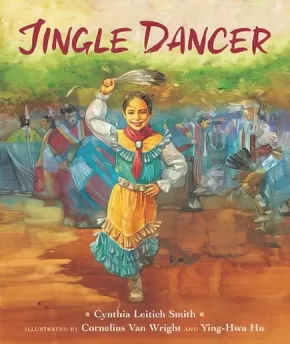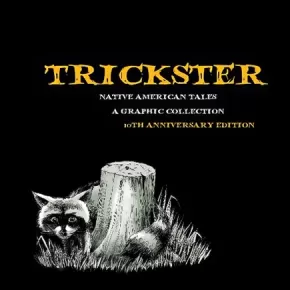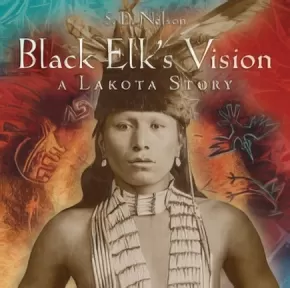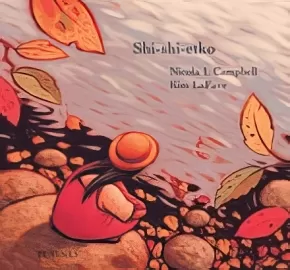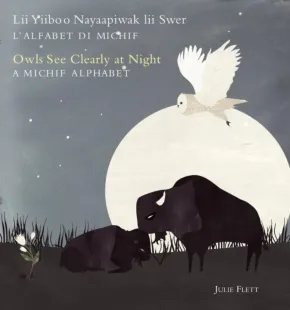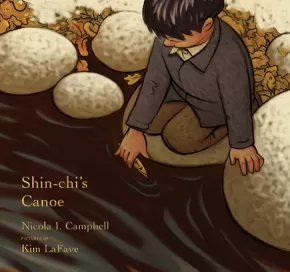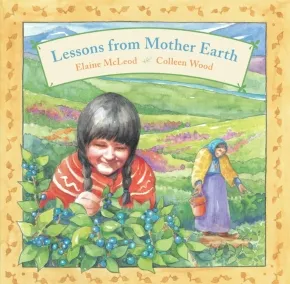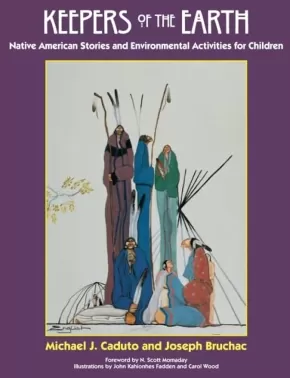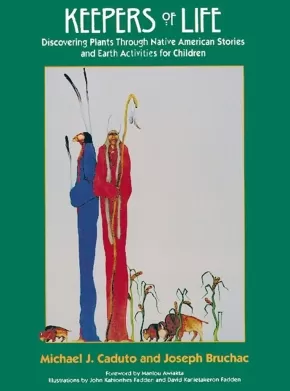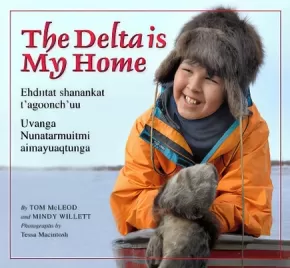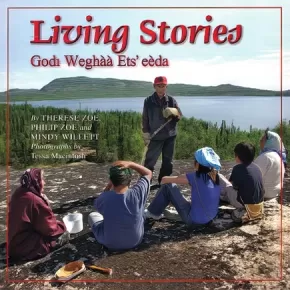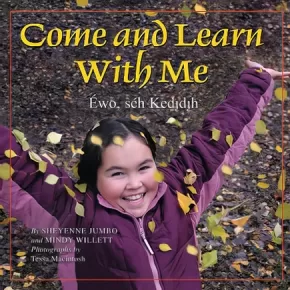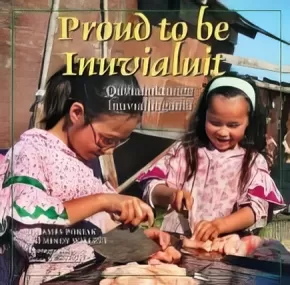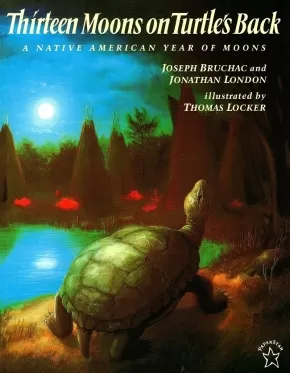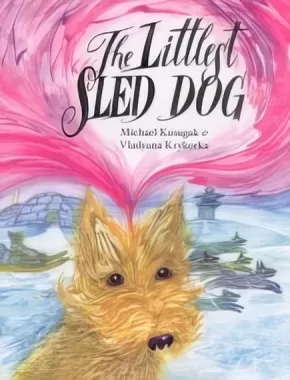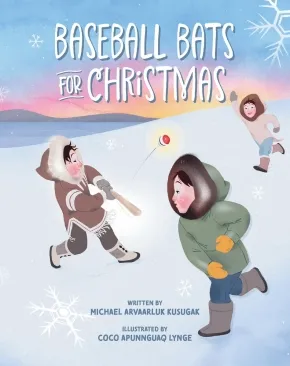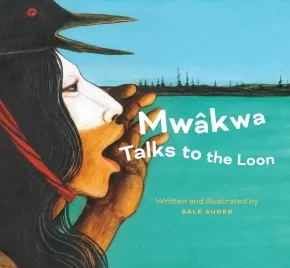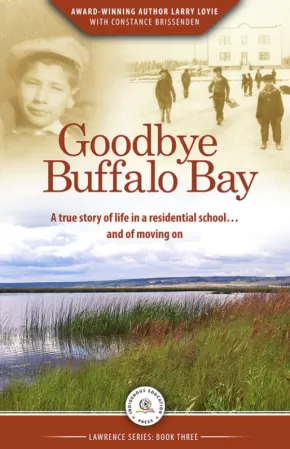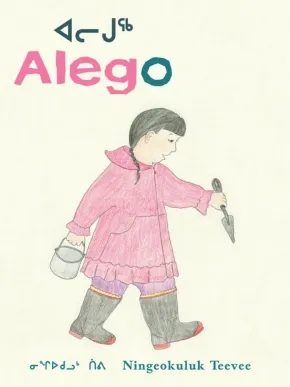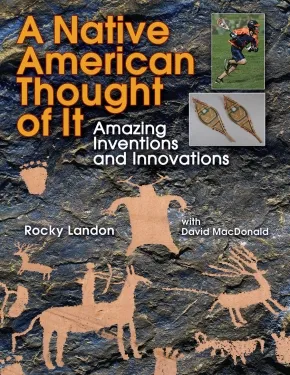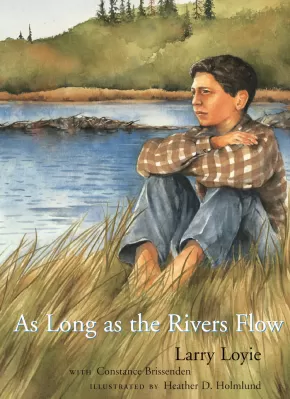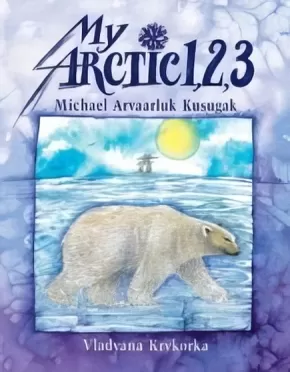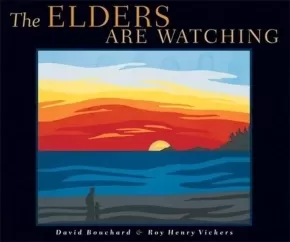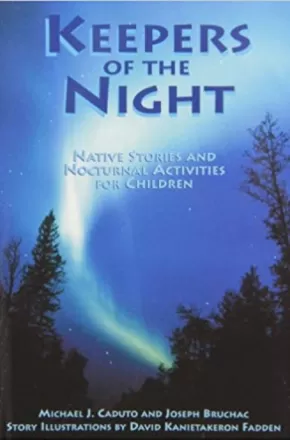
Grade 4
1
-
15
of
29 Results;
Sort By
Go To
of 2
Literature to Support First Nations, Métis and Inuit(FNMI) Student Success was developed by the Southern Alberta Professional Development Consortium. Date Published: June 2010
Click the following link to download a copy of the resource for this grade: (FNMI) Student Success - Grade 4
Jingle Dancer (PB)
$12.50
Artists:
Format:
Paperback
Text Content Territories:
Indigenous American; Native American; Muscogee (Creek);
ISBN / Barcode: 9780063018112
Synopsis:
Synopsis:
The affirming story of how a contemporary Native American girl turns to her family and community to help her dance find a voice.
Jenna, a contemporary Muscogee (Creek) girl, loves the tradition of jingle dancing that has been shared by generations of women in her family, and she hopes to dance at the next powwow. But she has a problem—how will her dress sing if it has no jingles?
The cone-shaped jingles sewn to Grandma Wolfe's dress sing tink, tink, tink, tink.
Jenna's heart beats to the brum, brum, brum, brum of the powwow drum as she daydreams about the clinking song of her grandma's jingle dancing.
The warm, evocative watercolors of Cornelius Van Wright and Ying-Hwa Hu complement author Cynthia Leitich Smith's lyrical text in this picture book. Perfect for classroom and library sharing.
Educator Information
Suggested Ages: 4-8.
Additional Information
32 pages | 9.25" x 11.00" | Paperback
A Promise Is a Promise: 30th Anniversary Edition
$7.95
Artists:
Format:
Paperback
Text Content Territories:
Indigenous Canadian; Inuit;
ISBN / Barcode: 9781773212937
Synopsis:
Synopsis:
When Allashua disobeys her parents and goes fishing on the sea ice, she has to use her wits to escape the Qallupilluit--the troll-like creatures her parents have always warned her about that live beneath the frozen surface of the sea. But the only way to break out of their grasp is through an exchange: Allashua can go free if she brings her brothers and sisters back to the sea ice instead. Allashua doesn't want to give them up, but what can she do? After all, a promise is a promise.
Educator Information
A Promise Is a Promise is a collaboration between award-winning storyteller Michael Kusugak and celebrated children's author Robert Munsch. This 30th anniversary edition brings all of the tension of the traditional Inuit story to a new generation of readers. Added features include a new foreword by Michael Kusugak on his role as a storyteller and the importance of storytelling in Inuit culture.
This resource is also available in French: Une Promesse, C'est Une Promesse
Additional Information
32 pages | 7.80" x 7.90"
Trickster: Native American Tales, A Graphic Collection, 10th Anniversary Edition
$39.95
Editors:
Format:
Paperback
Text Content Territories:
Indigenous American; Native American;
ISBN / Barcode: 9781682752739
Synopsis:
Synopsis:
All cultures have tales of the trickster, a crafty creature or being who uses cunning to get food, steal precious possessions, or simply cause mischief. He disrupts the order of things, often humiliating others and sometimes himself. In Native American traditions, the trickster takes many forms, from coyote or rabbit to raccoon or raven. The first graphic anthology of Native American trickster tales, Trickster brings together Native American folklore and the world of comics.
In Trickster more than twenty Native American tales are cleverly adapted into comic form. Each story is written by a different Native American storyteller who worked closely with a selected illustrator, a combination that gives each tale a unique and powerful voice and look. Ranging from serious and dramatic to funny and sometimes downright fiendish, these tales bring tricksters back into popular culture in a very vivid form. From an ego-driven social misstep in "Coyote and the Pebbles" to the hijinks of"How Wildcat Caught a Turkey" and the hilarity of "Rabbit's Choctaw Tail Tale", Trickster provides entertainment for readers of all ages and backgrounds.
Additional Information
248 pages | 8.00" x 8.00" | Paperback
Black Elk's Vision: A Lakota Story
$27.95
Artists:
Format:
Hardcover
Text Content Territories:
Indigenous American; Native American; Sioux; Lakota; Oglala Lakota;
ISBN / Barcode: 9780810983991
Synopsis:
Synopsis:
Told from the Native American point of view, Black Elk’s Vision provides a unique perspective on American history. From recounting the visions Black Elk had as a young boy, to his involvement in the battles of Little Big Horn and Wounded Knee, as well as his journeys to New York City and Europe with Buffalo Bill’s Wild West Show, this biographical account of Black Elk—an Oglala-Lakota medicine man (1863–1950)—follows him from childhood through adulthood.
S. D. Nelson tells the story of Black Elk through the medicine man’s voice, bringing to life what it was like to be Native American in the mid-to-late nineteenth century and early twentieth century. The Native people found their land overrun by the Wha-shi-choos, or White Man, the buffalo slaughtered for sport and to purposely eliminate their main food source, and their people gathered onto reservations. Through it all, Black Elk clung to his childhood visions that planted the seeds to help his people—and all people—understand their place in the circle of life. The book includes archival images, a timeline, a bibliography, an index, and Nelson’s signature art.
Reviews
“A fine choice for story hours, this will also find wide curricular use.” —Booklist
“A modern-day story in the Sioux tradition of storytelling.” —Winston-Salem Journal
“Splendid acrylic artwork captures the action, humor, and spirit of the tale. A solid addition to collections of Native American tales and an enjoyable read-aloud.” —School Library Journal
“Nelson pulls it off with his confident style as a storyteller . . . polished illustrations . . . informative, well written.” —Kirkus Reviews
Educator Information
F&P level: U
F&P genre: B
Additional Information
48 pages | 10.50" x 10.37"
Shi-shi-etko
$19.99
Artists:
Format:
Hardcover
Text Content Territories:
Indigenous Canadian;
ISBN / Barcode: 9780888996596
Synopsis:
Synopsis:
In just four days young Shi-shi-etko will have to leave her family and all that she knows to attend residential school.
She spends her last days at home treasuring the beauty of her world -- the dancing sunlight, the tall grass, each shiny rock, the tadpoles in the creek, her grandfather's paddle song. Her mother, father and grandmother, each in turn, share valuable teachings that they want her to remember. And so Shi-shi-etko carefully gathers her memories for safekeeping.
Richly hued illustrations complement this gently moving and poetic account of a child who finds solace all around her, even though she is on the verge of great loss -- a loss that native people have endured for generations because of the residential schools system.
This gentle story of a child on the verge of great loss was selected as the Aboriginal Children’s Book of the Year.
Awards
- Winner of the Anskohk Aboriginal Children's Book of the Year Award.
Educator Information
Recommended Grades: 1-10.
Curriculum Connections: Indigenous Studies, Visual Arts, Science, Health.
Recommended Authentic First Peoples resource K-9.
This illustrated children's story is recommended for English First Peoples Grades 10 for units pertaining to childhood through Indigenous writers' eyes and the exploration of residential schools and reconciliation through children's literature.
This book is available in French: Shi-shi-etko (French)
Additional Information
32 pages | 8.50" x 8.13"
Owls See Clearly at Night/Lii Yiiboo Nayaapiwak lii Swer: A Michif Alphabet/L'Alfabet Di Michif
$25.85
Artists:
Format:
Hardcover
Text Content Territories:
Indigenous Canadian; Métis;
ISBN / Barcode: 9781772290592
Synopsis:
Synopsis:
This picture book is a small glimpse, from A to Z, of some of the sights and sounds of the Michif language and its speakers.
The language of the Metis, Michif is a combination of French and Cree with a trace of other regional languages. Once spoken by thousands of people across the prairies of Canada and the northern United States, Michif is now so little spoken that it might disappear within a generation.
This alphabet book is part of a resurgence to celebrate and preserve the traditions of the Metis people. Here Michif and English words combine with images from Metis culture to introduce all generations to the unique Michif language. The book even includes a brief introduction to the language's history, a pronunciation guide, and a list of references for those interested in learning more about Michif.
Educator Information
Recommended for ages 5 to 8.
Dual-language: English and Michif.
Additional Information
56 pages | 8.25" x 9.00" | Hardcover
Shin-chi's Canoe
$18.95
Artists:
Format:
Hardcover
Text Content Territories:
Indigenous Canadian;
ISBN / Barcode: 9780888998576
Synopsis:
Synopsis:
This moving sequel to the award-winning Shi-shi-etko tells the story of two children's experience at residential school. Shi-shi-etko is about to return for her second year, but this time her six-year-old brother, Shin-chi, is going, too. As they begin their journey in the back of a cattle truck, Shi-shi-etko takes it upon herself to tell her little brother all the things he must remember: the trees, the mountains, the rivers and the tug of the salmon when he and his dad pull in the fishing nets. Shin-chi knows he won't see his family again until the sockeye salmon return in the summertime.
When they arrive at school, Shi-shi-etko gives him a tiny cedar canoe, a gift from their father. The children's time is filled with going to mass, school for half the day, and work the other half. The girls cook, clean and sew, while the boys work in the fields, in the woodshop and at the forge. Shin-chi is forever hungry and lonely, but, finally, the salmon swim up the river and the children return home for a joyful family reunion.
Awards
- 2009 TD Canadian Children’s Literature Award
- 2008 Governor General’s Literary Award for illustration
Reviews
"Shin-Chi’s Canoe is a story about a brother and sister sent to a residential school and the separation from their culture they experience. Shin-Chi finds comfort with a little cedar canoe and the dream of returning home like the salmon. The children both find peace and strength by connecting to Mother Earth and the water. The story acknowledges the residential school system's devastating events while highlighting Indigenous children's strength and resiliency." - The Dalai Lama Center
Educator Information
Recommended Grades: 2-10.
Recommended Authentic First Peoples K-9 resource.
This illustrated children's story is recommended for English First Peoples Grades 10 for units pertaining to childhood through Indigenous writers' eyes and the exploration of residential schools and reconciliation through children's literature.
This book is available in French: La pirogue de Shin-chi
Additional Information
40 pages | 8.50" x 8.13"
Lessons From Mother Earth
$10.99
Artists:
Format:
Paperback
Text Content Territories:
Indigenous Canadian; First Nations; Tutchone; Northern Tutchone; Na-Cho Nyak Dun;
ISBN / Barcode: 9780888998323
Synopsis:
Synopsis:
This gentle story demonstrates the First Nations' tradition of taking care of Mother Earth.
Tess has visited her grandmother many times without really being aware of the garden. But today when they step out the door, Tess learns that all of nature can be a garden. And if you take care of the plants that are growing, if you learn about them - understanding when they flower, when they give fruit, and when to leave them alone - you will always find something to nourish you.
At the end of the day, Tess is grateful to Mother Earth for having such a lovely garden, and she is thankful for having such a wise grandma.
Elaine McLeod's poetic text and Colleen Wood's gentle watercolors combine to make Lessons from Mother Earth a celebration of nature and life.
Educator Information
Curriculum Connections: Social Studies, Science and Nature.
Additional Information
24 pages | 8.80" x 8.80"
Keepers of the Earth: Native American Stories and Environmental Activities for Children
$33.95
Format:
Paperback
Text Content Territories:
Indigenous American; Native American;
ISBN / Barcode: 9781555913854
Synopsis:
Synopsis:
Native American stories combine with related hands-on activities to inspire children with a deep respect and interest in the Earth and in Native cultures in this popular and critically acclaimed book. Keepers of the Earth uses an interdisciplinary approach to introduce environmental concepts to children, aged five through twelve. The activities include theatre, reading, writing, science, social studies, and mathematics, and are designed to engage all of the senses.
Reviews
"Keepers of the Earth is an excellent school resource introducing children to Aboriginal worldviews. The book is comprised of 21 story packages which may be used as teaching tools in the classroom. The stories are divided by subject nature and include three stories about creation, two about fire, one about the earth, one about wind and weather, three about water, two about sky, one about seasons, six about plants and animals, one about life, death, and spirits, and about the unity of earth.... Following each story is a discussion prompt to help teachers explain the story’s context. The discussion prompts relate the story to First Nations traditional worldviews and emphasize mankind’s interconnection with the natural world. Following the discussion prompts, there is a list of questions to encourage student reflection. Some of the questions are focussed more on story comprehension while others encourage children to reflect on the greater meaning of the story and how it relates to their daily life.... Keepers of the Earth offers suggestions for activities to solidify and expand the learning of the story. Activity suggestions include field trips, demonstrations, experimentationand further discussion. Each story is accompanied by at least one activity with recommendations as to which age group tocater the activityto. While most of the activities seem directed at grades 3-8, there are many activities that could suit the needs of older or younger children with little or no modification." - Rachel Yaroshuk, CM Magazine
Educator & Series Information
This book is part of the Keepers Series.
Foreword by N. Scott Momaday.
Additional Information
240 pages | 8.25" x 10.72"
Keepers of Life: Discovering Plants through Native American Stories and Earth Activities for Children
$31.95
Format:
Paperback
Text Content Territories:
Indigenous American; Native American;
ISBN / Barcode: 9781555913878
Synopsis:
Synopsis:
The first paperback edition of Keepers of Life from the incredibly popular Keepers series.
These bestselling books have been long-time favourites with educators for their innovative approach to teaching children about Native cultures and the environment. Each book, co-authored by Joseph Bruchac and Michael J. Caduto, combines Native legends with information and activities about the natural world.
Reviews
"This book is an excellent school resource for introducing children to Indigenous worldviews. It is comprised of 18 story packages which may be used as teaching tools in the classroom. The stories are divided by subject nature and include one introduction story, two stories about creation, one about celebration, thanksgiving and stewardship, eight about flowers and fruits, seeds and spores, five about survival, and one about healing our relations. Each traditional story acknowledges the Native North American cultures in which the story originated. An accompanying map helps readers situate where these different cultural groups traditionally resided. The stories are typically one to three pages long, making them ideal for sharing in the oral tradition. The stories are accompanied by beautiful black and white ink drawings, artistically representing the events and characters in each story. Following each story is a discussion prompt to help teachers explain the story’s context. The discussion prompts relate the story to Native North American traditional worldviews and emphasize mankind’s interconnection with the natural world." - Rachel Yaroshuk, CM Magazine
Educator & Series Information
Books in the Keepers series are recommended by educational journals across North America for children aged 5 to 12.
Included at the end of the book is a Glossary and Pronunciation Key to Native North American Words and Names.
Foreword by Marilou Awiakta.
Additional Information
288 pages | 8.17" x 10.73"
The Delta Is My Home
$16.95
Format:
Hardcover
Text Content Territories:
Indigenous Canadian; Inuit; Inuvialuit (Mackenzie Inuit); First Nations; Dene; Dinjii Zhuh (Gwich'in);
ISBN / Barcode: 9781897252321
Synopsis:
Synopsis:
Tom McLeod is an eleven-year-old boy from Aklavik who is a gifted storyteller heard frequently on CBC Radio North. He is of mixed cultural heritage-Gwich'in and Inuvialuit.
Tom tells us why his home in the Mackenzie Delta is a special place and why he loves to live on the land. He describes how his town floods in the spring and why he loves "ratting" (trapping muskrats) and hunting "black ducks" (white-winged and surf scoters) in the Delta. Readers will learn why these ducks are decreasing in number and how and why they are important to Tom and his people.
Tom says, "Northerners have always hunted animals for survival. We are careful about how we use the land. To be good hunters we need to pay attention to what is happening on the land around us-that's why it's important for us to be out there. We are the first to know if the land and animals are changing."
Reviews
"The Delta is My Home, is presented in way children will take pleasure in reading. They will be enthralled with the photographs and in the end they will learn a great deal about the culture, family and life of Tom McLeod and the Gwich'in people." — ForeWord Magazine
"...a valuable introduction to an endangered culture." — Booklist
"Tom's bouncingly fun personality beams from every page. . . This is an exciting series for helping children, especially those outside the Northwest Territories, appreciate the day-to-day world of their peers." — Canadian Children's Book News
"[The Delta Is My Home] feature[s] a satisfying mix of old and new - traditional and contemporary - in the photographs and text. . . What both photos and text do very well is establish the strong connection between the people in the books and the land upon which they live. . . A book that children [will] choose to read both for pleasure and for information. — CM Magazine
Educator & Series Information
This book is part of the "The Land Is Our Storybook" series, which considers the diverse lands and cultures of Canada's Northwest Territories. Told in a uniquely diverse range of northern voices, with a child-centred approach, books in the series highlight each official Aboriginal language group in the NWT, revealing a richly textured picture of life in the North-on the trapline, around the campfire, in communities, at school, and within the outdoor school that is the land itself. The series celebrates the seasons, ages, genders, traditional activities, and communities of the NWT.
The stories are illustrated by the striking images of acclaimed northern photographer, Tessa Macintosh and depict the similarities in lifestyle between children of the North and South, as well as the marked cultural differences, and highlight the special relationship these First Nations people have with the land and how they are adapting to rapid change while remaining connected to the land. Images of the landscape and animals within it, of trapping, hunting, fishing, and bannock baking sit alongside pictures of children at school, swimming at recreation centres, and reading in libraries. Here is modern northern culture painted beautifully: a complex mix of the new and the old.
These wonderful books, written with a variety of provincial and territorial curricula in mind, are specially designed for the classroom and include special features such as glossaries relating details on animals biology and cultural definitions, regional and language maps. The text of the stories also have sidebars such as Our Stories, which contain the stories of the people and language group featured, and Our Words, which highlight words in the featured language that are important to the story.
Recommended Grade Level: 2-7
This resource is also available in French: Le Delta, c'est mon chez moi
Additional Information
32 pages | 8.00" x 8.00" | colour photographs, illustrations, map
Living Stories: Godi Weghàà Ets' eèda
$16.95
Artists:
Format:
Hardcover
Text Content Territories:
Indigenous Canadian; First Nations; Dene; Tlicho (Dogrib);
ISBN / Barcode: 9781897252444
Synopsis:
Synopsis:
The third title in "The Land is Our Storybook" series, by and about the people of the Northwest Territories, for readers at grade 4 - 7 level.
In Living Stories, Therese Zoe translates the stories and traditional wisdom of Tlicho Elders Philip Zoe and Elizabeth Chocolate.
Therese Zoe is a Tlicho woman from Gamèti in the Northwest Territories. She is a community health representative, a mother and grandmother, as well as a champion of ancestral skills and stories. In Living Stories, Therese shares her love for her community and translates the sacred stories and traditional wisdom of her brother-in-law, Philip Zoe, and his sister, Elizabeth Chocolate. As Therese writes, "You might look at our lands and think they are empty, but we do not go hungry. The land gives us our food and our shelter. It holds our stories and our histories. It gives us everything we need."
Join Tlicho young people, Shelinda, Forest, and Bradley, as they learn about making dry-fish, bows and arrows, and birch-bark baskets; the practices of old-time healers; as well as the sacred stories that tell the history of the Tlicho people. Some of the stories Philip relates in this book have never been written down before - his versions of sacred stories are a gift to young readers across Canada, to be used wisely. The Tlicho Nation was the first in the Northwest Territories to gain self-government. With Elders such as Philip and Elizabeth passing along their traditional wisdom to the young, as well as knowledge gained since the Tlicho first encountered European peoples, the Tlicho are showing how they are, "strong like two people."
Reviews
"Living Stories is a heartfelt tribute to the culture of the Tlicho or Dogrib nation. . . All of the information is presented in a very personal way so that young readers unfamiliar with the first nations culture in the north can realize this is a real way of life for some people, not something from 'long ago and far away'. . . Photographer Tessa Macintosh, a southerner whose children are Tlicho, has done a wonderful job of including pictures of the land and the people, some posed to represent the subject under discussions, many in cheerful candid shots." — CM Magazine
Educator & Series Information
This book is part of the "The Land Is Our Storybook" series, which considers the diverse lands and cultures of Canada's Northwest Territories. Told in a uniquely diverse range of northern voices, with a child-centred approach, books in the series highlight each official Aboriginal language group in the NWT, revealing a richly textured picture of life in the North-on the trapline, around the campfire, in communities, at school, and within the outdoor school that is the land itself. The series celebrates the seasons, ages, genders, traditional activities, and communities of the NWT.
The stories are illustrated by the striking images of acclaimed northern photographer, Tessa Macintosh and depict the similarities in lifestyle between children of the North and South, as well as the marked cultural differences, and highlight the special relationship these First Nations people have with the land and how they are adapting to rapid change while remaining connected to the land. Images of the landscape and animals within it, of trapping, hunting, fishing, and bannock baking sit alongside pictures of children at school, swimming at recreation centres, and reading in libraries. Here is modern northern culture painted beautifully: a complex mix of the new and the old.
These wonderful books, written with a variety of provincial and territorial curricula in mind, are specially designed for the classroom and include special features such as glossaries relating details on animals biology and cultural definitions, regional and language maps. The text of the stories also have sidebars such as Our Stories, which contain the stories of the people and language group featured, and Our Words, which highlight words in the featured language that are important to the story.
Recommended Grade Level: 4-7
This resource is also available in French: Nos histoires sont vivantes
Additional Information
32 pages | 8.00" x 8.00" | colour photographs and illustrations throughout
Come and Learn With Me: Ewo, seh Kedjdjh
$19.95
Artists:
Format:
Hardcover
Text Content Territories:
Indigenous Canadian; First Nations; Dene;
ISBN / Barcode: 9781897252574
Synopsis:
Synopsis:
Nine-year-old Sheyenne lives in Sambaa K'e, Northwest Territories-that's Trout Lake in English. Come learn with her as she takes you on a journey to her community in the fall, the season of moose.
This is the fourth book in the popular series "The Land Is Our Storybook" and features the Dehcho region of the Dene. "The Land Is Our Storybook" is a series of books about the lands and cultures of Canada's Northwest Territories. In the books, storytellers, elders, and cultural leaders from the ten regions in the Territories share real stories of everyday life in the North today.
Reviews
"The non-fiction book is colorful with rich, brilliant photographs and maps. Well-organized . . . Intriguing facts are contained within this book, making it a valuable resource for in classrooms, libraries, and homes. Come and Learn With Me can be used with both Aboriginal and non-Aboriginal readers to learn about Trout Lake's daily life during the fall moose season. This book will help preserve and keep the Dene Yatie (used to be known as South Slavey) group's language and culture alive. It is an innovative teaching tool and a 'must have' to read." — CM magazine
"Readers would be hard pressed to find a book of better quality whether it be for information, text, illustrations, layout, photography, or overall presentation. The text is well written and informative. The text is enhanced by maps, glossary, sidebars, graphics and stunning photography." — Resource Links
Educator & Series Information
This book is part of the "The Land Is Our Storybook" series, which considers the diverse lands and cultures of Canada's Northwest Territories. Told in a uniquely diverse range of northern voices, with a child-centred approach, books in the series highlight each official Aboriginal language group in the NWT, revealing a richly textured picture of life in the North -- on the trapline, around the campfire, in communities, at school, and within the outdoor school that is the land itself. The series celebrates the seasons, ages, genders, traditional activities, and communities of the NWT.
The stories are illustrated by the striking images of acclaimed northern photographer, Tessa Macintosh and depict the similarities in lifestyle between children of the North and South, as well as the marked cultural differences, and highlight the special relationship these First Nations people have with the land and how they are adapting to rapid change while remaining connected to the land. Images of the landscape and animals within it, of trapping, hunting, fishing, and bannock baking sit alongside pictures of children at school, swimming at recreation centres, and reading in libraries. Here is modern northern culture painted beautifully: a complex mix of the new and the old.
These wonderful books, written with a variety of provincial and territorial curricula in mind, are specially designed for the classroom and include special features such as glossaries relating details on animals biology and cultural definitions, regional and language maps. The text of the stories also have sidebars such as Our Stories, which contain the stories of the people and language group featured, and Our Words, which highlight words in the featured language that are important to the story.
This resource is also available in French: Viens avec moi: Nous apprendrons ensemble!
Additional Information
32 pages | 8.00" x 8.00" | colour photographs and illustrations, map
Proud to Be Inuvialuit: Quviahuktunga Inuvialuugama
$19.95
Artists:
Format:
Hardcover
Text Content Territories:
Indigenous Canadian; Inuit; Inuvialuit (Mackenzie Inuit);
ISBN / Barcode: 9781897252598
Synopsis:
Synopsis:
James Pokiak is proud to be Inuvialuit, which means "real people."
The Inuvialuit are the most westerly Canadian Inuit. James lives in the hamlet of Tuktoyuktuk, NWT, which is above the Arctic Circle on the shore of the Arctic Ocean. The community is often just called Tuk to save time. Even though he lives in town now, James grew up on the land, learning the traditional values and survival skills of his people.
In this book, the fifth in the The Land is Our Storybook series, James and his daughter, Rebecca, go on a trip to harvest beluga whale. Harvesting and preparing beluga meat together as a family is an integral part of what it means to be Inuvialuit. Join James and Rebecca and learn about how the beluga whale is interlinked with Inuvialuit culture and history.
Educator & Series Information
Recommended Ages: 8-12
This is the fifth book in the The Land Is Our Storybook Series, a first-ever series of books for children about the diverse lands and cultures of Canada's Northwest Territories.
Additional Information
32 pages | 8.33" x 8.25"
Thirteen Moons On Turtle's Back: A Native American Year Of Moons
$12.49
Format:
Paperback
Text Content Territories:
Indigenous American; Native American;
ISBN / Barcode: 9780698115842
Synopsis:
Synopsis:
To many Native Americans, the 13 cycles of the moon represent the changing seasons and the passage of time. Each moon has its own special name that, while varying among the tribal nations, is consistent with the legend that the 13 scales on Old Turtle's back hold the key to these moons. The authors present 13 poems that take readers through the year, from the "Moon of Popping Trees"--when the "cottonwoods crack with frost"--to the "Big Moon" of the Abenakis. The book's effective design consists of verses in vertical columns at the left of each spread, with the remainder occupied by Locker's ( Family Farm ; Catskill Eagle ) typically lush artwork. His oil paintings are eye-catching in their depth of color reflecting dramatic seasonal changes. Trees, skies and woodland creatures are rendered in vivid hues that combine to produce an enthralling vision. This unusual and intelligent book is an exemplary introduction to Native American culture with its emphasis on the importance of nature.
Additional Infromation
32 pages | 8.00" x 10.25"
The Littlest Sled Dog
$12.95
Format:
Paperback
Text Content Territories:
Indigenous Canadian; Inuit;
ISBN / Barcode: 9781554691746
Synopsis:
Synopsis:
Igvillu is a little dog with big dreams. One of her favorite dreams is of becoming a sled dog. When Igvillu is adopted from her kennel by an Inuit storyteller and moves to northern Canada, she comes face-to-face with real sled dogs. Igvillu loves living in the North, chasing siksiks and dreaming about her future. She''s a dog who believes anything is possible!
Baseball Bats for Christmas
$24.99
Artists:
Format:
Hardcover
Text Content Territories:
Indigenous Canadian; Inuit;
ISBN / Barcode: 9781773219721
Synopsis:
Synopsis:
Celebrate the 35th anniversary of this beloved holiday classic with a fresh edition that preserves the magic of the original story and brings it to life with stunning new illustrations.
The year is 1955. Arvaarluk and his friends watch Rocky Parsons land his plane on the ice in Repulse Bay, a tiny community “smack dab on the Arctic Circle.” Having never seen trees before, the children try to guess what the six green spindly things are that Rocky delivers. One of the boys has a brilliant idea: why not use them as baseball bats?
Michael Arvaarluk Kusugak is one of Canada’s foremost storytellers. Baseball Bats for Christmas captures the warmth and cadence of his voice as he describes the close-knit life of his community and the ingenuity he and his friends demonstrated when faced with something wholly unfamiliar.
Award-winning Inuk illustrator Coco Apunnguaq Lynge draws inspiration from the iconic work of Inuk artist Germaine Arnaktauyok to immerse the reader in the beauty of the Arctic landscape.
Educator Information
Recommended for ages 5 to 8.
Themes: Inuit; Arctic; community; multicultural; friends; resourcefulness.
Additional Information
32 pages | 8.50" x 10.75" | Hardcover
Mwâkwa Talks to the Loon: A Cree Story for Children - 2nd Edition
$12.95
Format:
Paperback
Text Content Territories:
Indigenous Canadian; First Nations; Cree (Nehiyawak);
ISBN / Barcode: 9781772034882
Synopsis:
Synopsis:
The award-winning story of a young Cree man blessed with the skills of a great hunter, who learns not to take his talents for granted.
Kayâs is a young Cree man who is blessed with a Gift that makes him a talented hunter. He knows the ways of the Beings he hunts and can even talk with them in their own languages. But when he becomes proud and takes his abilities for granted, he loses his gift, and the People grow hungry.
With the help of the Elders and the Beings that inhabit the water, Kayâs learns that in order to live a life of success, fulfillment and peace, he must cherish and respect the talents and skills he has been given.
Illustrated with Dale Auger's powerful, insightful paintings, Mwâkwa Talks to the Loon introduces readers to the basics of life in a Cree village. A glossary with a pronunciation guide to the many Cree words and phrases used in the story is included.
Awards
- The 1st edition was the winner of the Aboriginal Children's Book of the Year Award, 2006 Anskohk Aboriginal Literature Festival and Book Awards
Educator Information
Recommended Ages: 6-9.
Additional Information
32 pages | 10.00" x 9.25" | Paperback | 2nd Edition
Goodbye Buffalo Bay
$19.99
Format:
Paperback
Text Content Territories:
Indigenous Canadian; First Nations; Cree (Nehiyawak);
ISBN / Barcode: 9781990297274
Synopsis:
Synopsis:
A true story of life in a residential school and of moving on. Written by Award-Winning Cree author Larry Loyie with Constance Brissenden.
Goodbye Buffalo Bay is set during the author's teenage years. In his last year in residential school, Lawrence learns the power of courage to stand up for his beliefs. When he returns home he feels like a stranger to his family. The traditional First Nations life he once knew has changed. With Grandfather's guidance he finds his way. A book of self-discovery and the importance of friendship.
Educator & Series Information
This book is part of The Lawrence Series.
Recommended for grades 4 to 9.
Additional Information
142 Pages | Paperback
Alego
$17.99
Artists:
Format:
Hardcover
Text Content Territories:
Indigenous Canadian; Inuit;
ISBN / Barcode: 9780888999436
Synopsis:
Synopsis:
Alego is a beautifully simple story, written in Inuktitut and English, about a young Inuit girl who goes to the shore with her grandmother to collect clams for supper. Along the way she discovers tide pools brimming with life -- a bright orange starfish, a creepy-crawly thing with many legs called an ugjunnaq, a hornshaped sea snail and a sculpin.
Written and illustrated by Ningeokuluk Teevee, one of the most interesting young artists in Cape Dorset, home to the great tradition of Inuit art, this is an enchanting and utterly authentic introduction to the life of an Inuit child and her world.
Educator Information
Alego includes an illustrated glossary of sea creatures as well as a map of Baffin Island. Ages 4-7.
This book is delivered in a dual-language format, written in Inuktitut and English.
Curriculum Connections: Social Studies, Science, Visual Arts.
Additional Information
24 pages | 7.63" x 9.63"
A Native American Thought of It: Amazing Inventions and Innovations
$9.95
Format:
Paperback
Text Content Territories:
Indigenous American; Indigenous Canadian;
ISBN / Barcode: 9781554511549
Synopsis:
Synopsis:
Inventiveness and ingenuity from North America's First Nations.
Everyone knows that moccasins, canoes and toboggans were invented by the Aboriginal people of North America, but did you know that they also developed their own sign language, as well as syringe needles and a secret ingredient in soda pop?
Depending on where they lived, Aboriginal communities relied on their ingenuity to harness the resources available to them. Some groups, such as the Iroquois, were particularly skilled at growing and harvesting food. From them, we get corn and wild rice, as well as maple syrup.
Other groups, including the Sioux and Comanche of the plains, were exceptional hunters. Camouflage, fish hooks and decoys were all developed to make the task of catching animals easier. And even games-lacrosse, hockey and volleyball -- have Native American roots.
Other clever inventions and innovations include:
* Diapers
* Asphalt
* Megaphones
* Hair conditioner
* Surgical knives
* Sunscreen.
With descriptive photos and information-packed text, this book explores eight different categories in which the creativity of First Nations peoples from across the continent led to remarkable inventions and innovations, many of which are still in use today.
Educator & Series Information
This book is a part of the We Thought of It series, a series which takes readers on a fascinating journey across the world's second largest continent to discover how aspects of its culture have spread around the globe.
Additional Information
48 pages | 8.50" x 11.00"
Jenneli's Dance (8 in Stock)
$12.95
Artists:
Format:
Paperback
Text Content Territories:
Indigenous Canadian; Métis;
ISBN / Barcode: 9781894778619
Synopsis:
Synopsis:
Jenneli is a shy young girl who feels that she is nothing special, until she learns about the Métis Red-River Jig from her grandma. One day, Grandma Lucee enters her into a jigging contest. Jenneli's Dance is a story that instills a sense of pride in the Métis culture, and deals with low self-esteem.
Additional Information
44 pages | 7.94" x 9.02"
The Inuit Thought of It: Amazing Arctic Innovations
$9.95
Format:
Paperback
Text Content Territories:
Indigenous Canadian; Inuit;
ISBN / Barcode: 9781554510870
Synopsis:
Synopsis:
Dazzling inventions from the far north.
Today's Arctic communities have all the comforts of modern living. Yet the Inuit survived in this harsh landscape for hundreds of years with nothing but the land and their own ingenuity. Join authors Alootook Ipellie and David MacDonald as they explore the amazing innovations of traditional Inuit and how their ideas continue to echo around the world.
Some inventions are still familiar to us: the one-person watercraft known as a kayak retains its Inuit name. Other innovations have been replaced by modern technology: slitted snow goggles protected Inuit eyes long before sunglasses arrived on the scene. And other ideas were surprisingly inspired: using human-shaped stone stacks (lnunnguat) to trick and trap caribou.
Many more Inuit innovations are explored here, including:
- Dog sleds
- Kids' stuff
- Shelter
- Food preservation
- Clothing
- Medicine.
In all, more than 40 Inuit items and ideas are showcased through dramatic photos and captivating language. From how these objects were made, to their impact on contemporary culture, The Inuit Thought of It is a remarkable catalog of Inuit invention.
Educator & Series Information
Recommended Ages: 10-12.
B.C. Science Supplementary Resource: Gr.3- Physical Science
B.C. Science Supplementary Resource Gr.4- Life Science
This book is a part of the We Thought of It series, a series which takes readers on a fascinating journey across the world's second largest continent to discover how aspects of its culture have spread around the globe.
Additional Information
32 pages | 8.50" x 11.00"
As Long As the Rivers Flow (PB)
$12.99
Artists:
Format:
Paperback
Text Content Territories:
Indigenous Canadian; First Nations; Cree (Nehiyawak);
ISBN / Barcode: 9780888996961
Synopsis:
Synopsis:
In the 1800s, the education of First Nations children was taken on by various churches, in government-sponsored residential schools. Children were forcibly taken from their families in order to erase their traditional languages and cultures.
As Long as the Rivers Flow is the story of Larry Loyie's last summer before entering residential school. It is a time of learning and adventure. He cares for an abandoned baby owl and watches his grandmother make winter moccasins. He helps the family prepare for a hunting and gathering trip.
Sequel: Goodbye Buffalo Bay
Awards
- In 2006, As Long As the Rivers Flow was the award recipient for First Nation Communities Read.
- Winner of the Norma Fleck Award for Canadian Children's Non-Fiction
Educator Information
Recommended for ages 7 to 11.
Curriculum Connections: Indigenous Studies, Social Studies, Science and Nature.
This resource is also available in French: Tant que couleront le rivieres.
Additional Information
48 pages | 7.25" x 10.25"
My Arctic 1,2,3
$9.95
Artists:
Format:
Paperback
Text Content Territories:
Indigenous Canadian; Inuit;
ISBN / Barcode: 9781550375046
Synopsis:
Synopsis:
Readers discover counting and creatures, and learn who's predator and who's prey. They witness five Arctic foxes hunting six furry siksiks. They watch seven fisherman catch eight Arctic char. Numbers explored include 1 to 10, 20, 100 and even 1,000,000 millions of berries ripen in the fall.
Reviews
"From one polar bear walking along the edge of a huge ice floe to millions of berries ready for picking, My Arctic 1, 2, 3 takes young readers on a counting tour in the Far North. With the rich Arctic environment as a background, this classic not only provides small children with opportunities to practice their counting skills, it introduces them to the extraordinary animals that make the Far North their home. Stunning artwork, the author's memories of life in the Arctic and information about many of the featured animals make My Arctic 1, 2, 3 the perfect book for families to share and cherish. You can count on it!" - Parent Council
"A fascinating tale... The book is well thought out, colourful and imaginative, giving us a glimpse of life in the vast Arctic. Recommended."
— Naomi Gerrard, reviewer for Amelia Frances Howard-, Children's Materials, Vol. 3, No. 2, September 1996
"Emerging readers will appreciate the easy-to-read, large print...A unique addition for libraries, particularly those building multicultural or Arctic-region collections." — School Library Journal
Educator Information
Recommended Ages: 4-6.
Numbers are in Inuktitut and English.
Additional Information
24 pages | 8.25" x 10.50"
The Elders Are Watching (2 in Stock)
$21.95
Format:
Hardcover
Text Content Territories:
Indigenous Canadian;
ISBN / Barcode: 9781551926414
Synopsis:
Synopsis:
When award-winning writer David Bouchard first saw the work of First Nations artist Roy Henry Vickers, he was struck by Vickers' reverence for nature and his understanding of Canada's rugged West Coast. They collaborated on The Elders Are Watching, which-now in its fifth printing-has delighted more than 100,000 readers in four languages. The artwork in this new edition has been restored to match the vibrancy of the originals.
The boy looked much the same as the other kids in his class. New faces arrived almost daily from far away places, so it wasn't his appearance that made him different.
He had always tried his hardest, but try as he might, somehow he didn't seem to be able to get excited about the same things his classmates did. This year would be no different.
And so, as in years gone by, his mother would please him greatly by taking him out of school for a time. Again, she was sending him to live with his grandfather, his 'Ya-A' - to listen, to think and to learn.
'Ya-A' would reintroduce him to the Wind, the Tree and the Earth. 'Ya-A' would speak of responsibilities and of rights. 'Ya-A' would fascinate him with legends of the eagle, the whale, the raven and the wolf.
Of all the tales his grandfather told, none captured his heart more than the stories of the Old Ones - the Elders. And as the stories slowly became a part of him, by the seashore in the clear red sky of early evening, he began to see them.
They appeared as images suspended in the air, up toward the sun. Their lips were still, yet he heard them speak. Their message, like the words of his "Ya-A', was clear and true, a message gone too long without being passed to other hearts.
He and his "Ya-A' would share the words of the Elders often with all those who cared to listen - with all those who cared at all. ...taken from The Elders Are Watching.
Additional Information
56 pages | 10.94" x 9.06" | Hardcover
Morning On The Lake
$7.99
Artists:
Format:
Paperback
Text Content Territories:
Indigenous Canadian; First Nations; Anishinaabeg; Ojibway;
ISBN / Barcode: 9781550745887
Synopsis:
Synopsis:
A young boy and his grandfather set out in a birchbark canoe early one spring morning. Under the patient and gentle guidance of his grandfather, the boy gradually comes to respect the ways of nature and to understand his own place in the world.
In the first of three linked stories, a young boy and his grandfather set out in a birchbark canoe early one spring morning. Together, they discover the peaceful beauty of the lake. In the second story, the sun rises high in the summer sky as they climb a rocky cliff for a bird's-eye view of the land. And, finally, as an autumn night descends, they venture into the woods. Under the patient and gentle guidance of his grandfather, the boy gradually comes to respect the ways of nature and to understand his own place in the world.
Reviews
"Filled with lessons of love and respect for Mother Earth, this book is packed with many Ojibway cultural references for young readers. Noshen and his grandfather, Mishomis, set off in a birchbark canoe, climb a mountain and stand off a pack of wolves - all in one day. Noshen learns that he is brother to the wolves and need not be afraid of any animal he meets in the woods. Karen Reczuch's illustrations of many culturally-relevant objects like beadwork designs and Mishomis' moccasins make this book something to be treasured." —Aboriginal Voices
"From the first words of Morning on the Lake, it's evident the author has an abundance of love and respect for the force of nature in all its magnificence. And, as we follow the young native protagonist and his grandfather, the call of the wild sounds ever more clear. Early one morning, the boy and his grandfather set off in their canoe and are rewarded with a rare glimpse of a family of loons. Later that day, they climb to the top of a hill and have an encounter with a bald eagle. And in the still night, the boy comes face to face with a pack of wolves. In this boy's traditional world, nature is given very human qualities which can set the heart a-thumping as well as soothe the spirit. Karen Reczuch's tranquil illustrations lovingly portray the relationship between man and his surroundings." —Children's Book News
Educator Information
Recommended for ages 5 to 9.
Additional Information
32 pages | 10.00" x 9.00"
I'm In Charge Of Celebrations (3 in Stock) - ON SALE
$9.60 $11.99
Artists:
Format:
Paperback
ISBN / Barcode: 9780689806209
Synopsis:
Synopsis:
From the highly acclaimed team of Byrd Baylor and Peter Parnall comes the story of a girl who shares her love for desert life as she tells of treasured experiences like dancing in the wind on Dust Devil Day or sleeping outside on a hot summer night during The Time of the Falling Stars. Baylor's radiant prose-poem and Parnall's exquisite illustrations combine to create a joyous celebration of the human spirit.
Reviews
"With a text by Byrd Baylor and pictures by Peter Parnall, this delightful book will inspire you to create your own holidays. "Last year I gave myself one hundred and eight celebrations — besides the ones that they close school for," announces a young girl. She lives in the desert and just laughs when people suggest that she might get lonely. How could she get lonely when there are so many things around her that catch her attention and fill her with wonder?" - Frederic and Mary Ann Brussat, Spirituality Practice
Additional Information
32 pages | 8.00" x 10.00"
Keepers of the Night: Native Stories and Nocturnal Activities for Children
$14.95
Format:
Paperback
Text Content Territories:
Indigenous American; Native American;
ISBN / Barcode: 9781895618396
Synopsis:
Synopsis:
Native lore, stories, and activities encourage children to explore the fascinating night world. By studying astronomy, Native beliefs, nighttime weather, and North American nocturnal plants and animals, children aged 5 to 12 learn to appreciate the importance of night in the natural cycle and overcome common fears about the nighttime world.
Educator & Series Information
B.C. Science Supplementary Resource: Gr.3-Earth and Life Science
B.C. Science Supplementary Resouce Gr.4- Life Science.
Filled with interdisciplinary activities, legends, and illustrations to inspire children and educators alike.
This book is part of the Keepers series.
Additional Information
146 pages | 9.75" x 6.75"
Sort By
Go To
of 2

